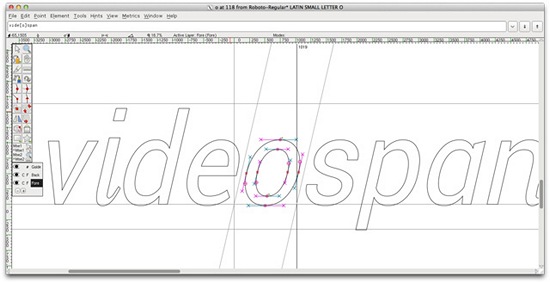

#Using fontforge code#
#Using fontforge install#
Do not simply install it with the original still there, because Scribus will invariably only load just one version of the font at a time.

Now all that remains to be done is uninstalling the previous installed font and replace it with the new one. If your original font was a PostScript or TrueType, do not worry since OpenType can use both vector formats. I personally always use the OpenType CFF type, so I cannot tell about other types. In the dialog, enter the desired name, I personally use the original name and add “_EDITED” just before the extension. To export your font use File, Generate Fonts. This might be handy for future addings/changes to the font. If you wish to further edit the file after a close, go to the File menu, and select Save As. EM space at uni2003, 1000 (move it and put it back in place to enable it) Īfter you have done this, all that remains is exporting and/or saving your file.Now you will do the same on every character that remains to be edited with the following units: That’s all you had to to edit the EN space. The character on the map you have first opened when importing the font should now have a black header and there also should not be the red cross anymore. If you have problems moving it precisely with the mouse, you can move it by 1pt increments with the arrow keys. You move it to 500 because this character, the EN space, is M/2, where M=1000, thus 1000/2. There is a vertical line, the green one in this image, that by default should be located to 1000 and be black. Now, double-click on it, it should open a new window. The highlighted character currently has an red cross in it, indicating that this character is not currently included in the font. The text in red displays the current characted selected, in this case the 2002. I will explain what is what in this image. Now, the Unicode character 2002, which is the EN space, should be selected. If your imported font is not using Unicode encoding, I suggest you re-encode it with Encoding, then Reencode and finally select any of both Unicode format, BMP will do for most uses.

You might get some warnings at opening, this is generally not important and should work very well anyway. Locate the one you will be editing and click Okay.

By default, the application will ask you to open your font file. Now that you have done this, launch FontForge. While FontForge doesn’t edit font files directly, I wouldn’t take any chance overwriting by error my precious fonts when exporting the fresly edited font.
#Using fontforge license#
Please make sure that your font license allows modifications, don’t assume they do because it’s really not the case. To begin with, you will need a font file and (in this case solely but not limited to) the FontForge editor, which is available under most platforms and is free. In this case, I will be editing one of my favourite: Caecilia Roman by Linotype.
#Using fontforge how to#
I write this guide with the intent of showing you how to edit your fonts to make use of these features possible. You might have found yourself using fonts that, sadly, do not support those characters.


 0 kommentar(er)
0 kommentar(er)
